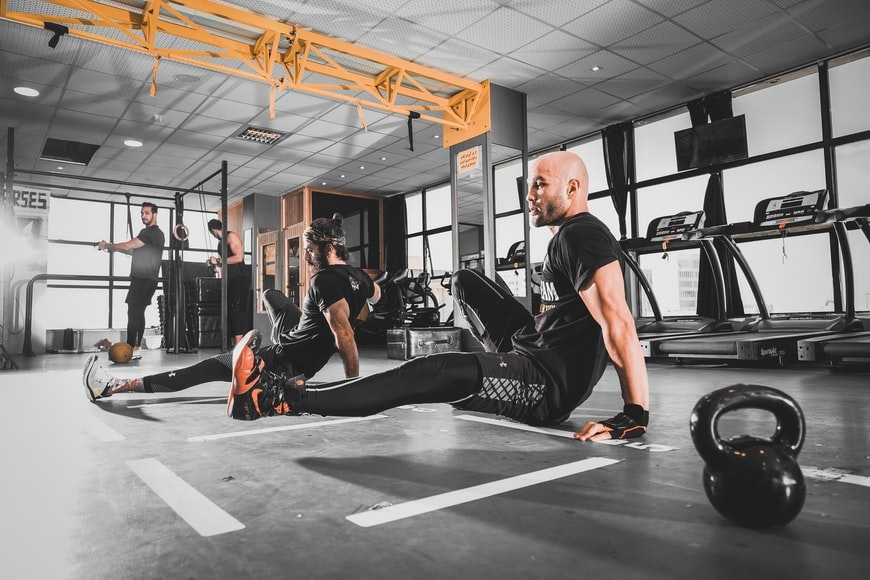Fitness assessments are a great way to measure new members fitness levels. Providing club members with accurate data that they can use and work on can motivate them to continue coming back to your gym. Offering quarterly fitness assessments can increase retention and member satisfaction. What's more, PerfectGym has an automation module that can remind you when to provide fitness assessments to your members.
This article will describe fitness assessments and their related benefits and the most crucial things to consider before conducting a fitness test.
Source
What is a fitness assessment?
A fitness assessment or fitness test is designed to evaluate a person's physical fitness level and capabilities by participating in several trials. Fitness assessments are a valuable piece of information for many reasons, such as:
- To measure a person's current fitness levels when they join a gym.;
- To track the progress of the members after beginning in their new environment.
- To determine their level of fitness to judge their suitability in a role that requires vigorous physical activity. I.e., in the military or police force.
- To determine your general health and wellbeing.
Once you have an idea of the member's fitness level, the next step is to devise suitable exercises and fitness programs to help them improve. For this purpose of the article, the assessments discussed will focus on ones you can use as a fitness business owner. Before getting started on your fitness assessment, there are some things to keep in mind.
Things to consider being completing a fitness assessment
Not everyone is the same, and with one's fitness - many factors can impact the way you view and process their results.
It's essential to consider the member's age, injury history, and what they are actually trying to achieve (their goals!). The following variables listed below should be carefully considered in order to give the best advice specific to the member.
Age
The member's age will determine the level of intensity their fitness assessment should be and will influence what exercises you will ask them to complete. The WHO suggests the recommended amount of physical activity relating to three key age groups:
5-17 years — A minimum of 60 minutes per day of moderate to vigorous intensity
18-64 years — A minimum of 150 minutes of moderate exercise through the week
65+ years — A minimum of 150 minutes of moderate-intensity activity throughout the week.
When conducting a fitness assessment, putting the age and capabilities of the member at the forefront will help create a more individualised plan. This practice can increase the chances that the client will keep driving towards their goals.
Source
Sadly yet realistically, injuries are a fact of life, and no one is impervious to being struck down by some ailment, either in their day-to-day lives or whilst training. Indeed, physical exertion can come with risks without adequately warming up or misusing equipment.
It can be a bright idea to do your due diligence before putting together a fitness assessment. There is value in conducting a questionnaire at the beginning of the process to understand the member's precise injury history to account for their physical weaknesses. By having this information, you can tailor the assessment and their exercise program to ensure they get the right results – without exposing them to injury.
Member specific goals
People join gyms for many reasons, but above all is the ambition to achieve results.
Understanding exactly what a member wants to achieve is key to making them feel cared for and motivated to continue training. Forcing them to participate in activities that have no bearing on their ambitions is an unnecessary task.
When you have an idea of what kind of things that person wants to achieve, be it weight loss, muscle gain or conditioning for a sport, you can synthesise a client-specific and accurate baseline for them to get started.
Source
What are the benefits of regular fitness assessments?
Of the many benefits of fitness testing, the most important is to establish the strengths and weaknesses of the member. This can be done by comparing fitness test results to other members in the same training group, the same sport, or a similar population group.
The initial testing session can give you and the member an idea of their fitness levels at the start of a program. In this method, ongoing testing can be used as a yardstick, and any changes can be tracked and monitored. Establishing a baseline of this kind is especially important if a new member is embarking on a fresh training regime.
Subsequent fitness assessments should be scheduled for the end and start of each new phase. Repeating tests at regular intervals will indicate the effectiveness of the training program. The period between tests can depend on the availability of time or costs involved or the training phase the member is undertaking. Some beneficial reasons for ongoing fitness tests are listed below:
- Obtain scientific baseline measurements of member's fitness levels
- Learn how movement patterns contribute to exercise routine and daily life
- Develop a personal awareness of your physical health
- Establish attainable goals and maintain accountability
- Keeps members motivated to continue training at your gym (retention piece)
- Allows members to see a measurable change in their progress
- Identify limitations that could potentially put them at risk of injury
- Increases their self-awareness and self-confidence in any fitness environment
Sourece
Five elements of fitness assessments
Make the most of PerfectGym's open API ecosystem with third-party integrations. The open-API allows third-party integrations with wearables like MyZone or FitBit. Customisable training statistics such as the number of calories burnt, steps taken and their heart rate are all recorded here. Members can view these statistics in the PerfectGym app, and can compare this data with any future sessions to evaluate and track their progress. The information compiled during these sessions can be used as a yardstick for the fitness assessment, providing real-time data of their progress and improvement.
PerfectGym's fully automated processes can help with the time-consuming tasks of your fitness club such as member engagement. Implementing techniques such as automated emails, push notifications and SMS alerts will assist in saving you and your employees' tonnes of time and effort. Simply set automated reminders to keep track of when each member is due for a fitness assessment to evaluate their progress and keep them motivated. The automation functionality is designed to send notifications independently and helps reduce the administrative tasks that staff have to stay on top of.
Source
Here are some of the best techniques to test your members and have their data stored in one place:
-
General health evaluation - As mentioned, fitness assessments should begin with a general health evaluation or questionnaire to assess the member's capabilities. A personal trainer is assigned to the member to coordinate and monitor their progress and mentor the member. If the member has a history of injuries, it would be wise to have their exercise checked off by a medical professional to ensure they are suitable for the upcoming program.
Most fitness specialists will use one or more screening tools to help determine your baseline health. One example is a cutting-edge piece of tech named FitQuest, used by the establishment GoFit gym. This machine combines an intuitive interface with a meaningful analysis of your body fat, muscle percentage, hydration levels and more.
-
Body composition testing - comprises the various components that account for total body weight, including your muscles, bones, and fat. The most common methods for estimating body composition include:
-
Bioelectrical impedance analysis (BIA): Electrical signals are sent from electrodes on the soles of your feet to your abdomen to estimate your body composition.
-
Body mass index (BMI): A general calculation of body fat based on your height and weight
-
Skinfold measurements: Calipers are often used to estimate how much body fat is in a fold of skin.
-
Cardiovascular endurance testing - Cardiovascular endurance testing, also known as stress testing, is designated to measure how efficiently your heart and lungs work to supply oxygen and energy to your body during physical activity. Among the three most common tests used:
-
12-minute run tests: Performed on a treadmill to compare the pre and post-exercise heart and respiration rates.
-
Exercise stress: Performed on a treadmill or spinning bike and involves measuring vital signs during exercise.
-
VO2 max testing: Performed on a treadmill or spinning bike to measure the maximum oxygen consumption rate during an activity.
-
Strength and endurance testing - Strength testing measures the total amount of force a muscle group can exert during exercise. On the other hand, muscle endurance testing measures the time a muscle group can contract and release before it begins to fatigue. Some commonly used practices include:
-
Push-up tests
-
Squats (or sitting down and getting up from a chair, repeatedly)
-
Core strength and stability tests such as planks
-
Flexibility testing - The process of measuring the flexibility of joints is vital in determining whether someone might have postural imbalances, foot instability, or limitations in your range of motion.
Increased flexibility can help in preventing and relieving pain, correcting posture, and preventing musculoskeletal injury. Interestingly, recent studies have suggested that stretching before exercising actually impedes performance. Still, the therapeutic benefits are clear; consulting a great fitness professional will strategise a program to incorporate stretching into your exercise plan to maintain flexibility. There are several different tests possible to measure flexibility, including:
Source
A word from PerfectGym
Fitness assessment tests are valuable for their worth in indicating where a person needs to spend more time improving and keeping them engaged with your brand.
By helping the individual with their own goals and ambitions, they become more invested in what they are trying to achieve and develop a fiercer loyalty to the gym where they are training.
Club automation can be a complex subject for fitness clubs. However, with PerfectGym's Automation Center, you can control who gets messages, how often, and how they receive them to keep your clients informed at the levels they desire.
Cover image source











